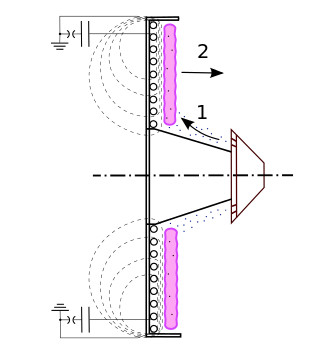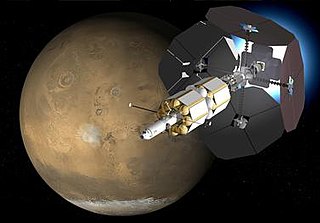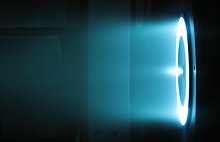
Spacecraft propulsion is any method used to accelerate spacecraft and artificial satellites. In-space propulsion exclusively deals with propulsion systems used in the vacuum of space and should not be confused with space launch or atmospheric entry.
A resistojet is a method of spacecraft propulsion that provides thrust by heating a typically non-reactive fluid. Heating is usually achieved by sending electricity through a resistor consisting of a hot incandescent filament, with the expanded gas expelled through a conventional nozzle.
An arcjet rocket or arcjet thruster is a form of electrically powered spacecraft propulsion, in which an electrical discharge (arc) is created in a flow of propellant. This imparts additional energy to the propellant, so that one can extract more work out of each kilogram of propellant, at the expense of increased power consumption and (usually) higher cost. Also, the thrust levels available from typically used arcjet engines are very low compared with chemical engines.

In spacecraft propulsion, a Hall-effect thruster (HET) is a type of ion thruster in which the propellant is accelerated by an electric field. Hall-effect thrusters are sometimes referred to as Hall thrusters or Hall-current thrusters. Hall-effect thrusters use a magnetic field to limit the electrons' axial motion and then use them to ionize propellant, efficiently accelerate the ions to produce thrust, and neutralize the ions in the plume. The Hall-effect thruster is classed as a moderate specific impulse space propulsion technology and has benefited from considerable theoretical and experimental research since the 1960s.

An ion thruster, ion drive, or ion engine is a form of electric propulsion used for spacecraft propulsion. An ion thruster creates a cloud of positive ions from a neutral gas by ionizing it to extract some electrons from its atoms. The ions are then accelerated using electricity to create thrust. Ion thrusters are categorized as either electrostatic or electromagnetic.

A magnetoplasmadynamic (MPD) thruster (MPDT) is a form of electrically powered spacecraft propulsion which uses the Lorentz force to generate thrust. It is sometimes referred to as Lorentz Force Accelerator (LFA) or MPD arcjet.
A pulsed plasma thruster (PPT), also known as a plasma jet engine, is a form of electric spacecraft propulsion. PPTs are generally considered the simplest form of electric spacecraft propulsion and were the first form of electric propulsion to be flown in space, having flown on two Soviet probes starting in 1964. PPTs are generally flown on spacecraft with a surplus of electricity from abundantly available solar energy.

A fusion rocket is a theoretical design for a rocket driven by fusion propulsion that could provide efficient and sustained acceleration in space without the need to carry a large fuel supply. The design requires fusion power technology beyond current capabilities, and much larger and more complex rockets.

A pulsed inductive thruster (PIT) is a form of ion thruster, used in spacecraft propulsion. It is a plasma propulsion engine using perpendicular electric and magnetic fields to accelerate a propellant with no electrode.

The Variable Specific Impulse Magnetoplasma Rocket (VASIMR) is an electrothermal thruster under development for possible use in spacecraft propulsion. It uses radio waves to ionize and heat an inert propellant, forming a plasma, then a magnetic field to confine and accelerate the expanding plasma, generating thrust. It is a plasma propulsion engine, one of several types of spacecraft electric propulsion systems.
A propellant is a mass that is expelled or expanded in such a way as to create a thrust or another motive force in accordance with Newton's third law of motion, and "propel" a vehicle, projectile, or fluid payload. In vehicles, the engine that expels the propellant is called a reaction engine. Although technically a propellant is the reaction mass used to create thrust, the term "propellant" is often used to describe a substance which contains both the reaction mass and the fuel that holds the energy used to accelerate the reaction mass. For example, the term "propellant" is often used in chemical rocket design to describe a combined fuel/propellant, although the propellants should not be confused with the fuel that is used by an engine to produce the energy that expels the propellant. Even though the byproducts of substances used as fuel are also often used as a reaction mass to create the thrust, such as with a chemical rocket engine, propellant and fuel are two distinct concepts.

Laser propulsion is a form of beam-powered propulsion where the energy source is a remote laser system and separate from the reaction mass. This form of propulsion differs from a conventional chemical rocket where both energy and reaction mass come from the solid or liquid propellants carried on board the vehicle.

Solar electric propulsion (SEP) refers to the combination of solar cells and electric thrusters to propel a spacecraft through outer space. This technology has been exploited in a variety of spacecraft designs by the European Space Agency (ESA), the JAXA, Indian Space Research Organisation (ISRO) and NASA. SEP has a significantly higher specific impulse than chemical rocket propulsion, thus requiring less propellant mass to be launched with a spacecraft. The technology has been evaluated for missions to Mars.

The gridded ion thruster is a common design for ion thrusters, a highly efficient low-thrust spacecraft propulsion method running on electrical power by using high-voltage grid electrodes to accelerate ions with electrostatic forces.

A plasma propulsion engine is a type of electric propulsion that generates thrust from a quasi-neutral plasma. This is in contrast with ion thruster engines, which generate thrust through extracting an ion current from the plasma source, which is then accelerated to high velocities using grids/anodes. These exist in many forms. However, in the scientific literature, the term "plasma thruster" sometimes encompasses thrusters usually designated as "ion engines".

SERT-1 was a NASA probe used to test electrostatic ion thruster design and was built by NASA's Lewis Research Center. SERT-1 was the first spacecraft to utilize ion engine design. It was launched on July 20, 1964 on a Scout rocket. It carried two electric propulsion engines; of the two, the first, an electron-bombardment ion engine was run for a total of 31 minutes and 16 seconds. This was the first time that an ion engine of any type had been operated in space, and demonstrated that the neutralizer worked as predicted.
Field propulsion is the concept of spacecraft propulsion where no propellant is necessary but instead momentum of the spacecraft is changed by an interaction of the spacecraft with external force fields, such as gravitational and magnetic fields from stars and planets. Proposed drives that use field propulsion are often called a reactionless or propellantless drive.
Atmosphere-breathing electric propulsion, or air-breathing electric propulsion, shortly ABEP, is a propulsion technology for spacecraft, which could allow thrust generation in low orbits without the need of on-board propellant, by using residual gases in the atmosphere as propellant. Atmosphere-breathing electric propulsion could make a new class of long-lived, low-orbiting missions feasible.
A thruster is a spacecraft propulsion device used for orbital station-keeping, attitude control, or long-duration, low-thrust acceleration, often as part of a reaction control system. A vernier thruster or gimbaled engine are particular cases used on launch vehicles where a secondary rocket engine or other high thrust device is used to control the attitude of the rocket, while the primary thrust engine is fixed to the rocket and supplies the principal amount of thrust.
Microwave electrothermal thruster, also known as MET, is a propulsion device that converts microwave energy into thermal energy. These thrusters are predominantly used in spacecraft propulsion, more specifically to adjust the spacecraft’s position and orbit. A MET sustains and ignites a plasma in a propellant gas. This creates a heated propellant gas which in turn changes into thrust due to the expansion of the gas going through the nozzle. A MET’s heating feature is like one of an arc-jet ; however, due to the free-floating plasma, there are no problems with the erosion of metal electrodes, and therefore the MET is more efficient.











